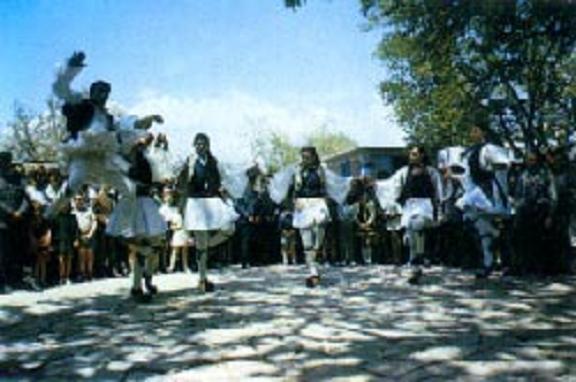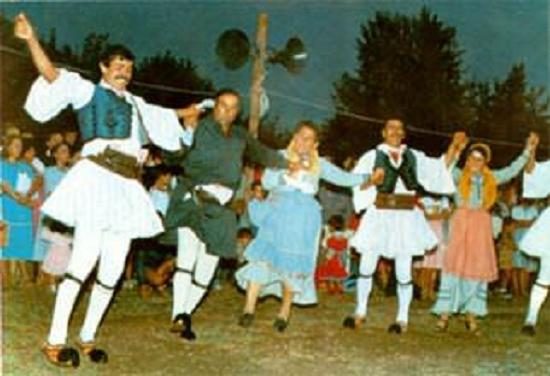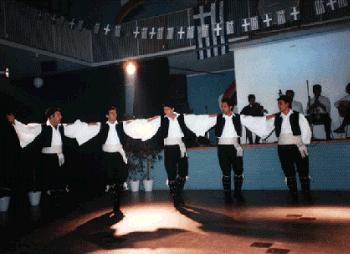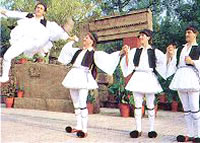Greek
Traditional Dances
Dance is the rhythmical movement of one or more persons accompanied with music
or song. For ancient Greeks, dance was a gift from Gods, to forget their problems.
Informations about dances in ancient Greece, we have from Homer and many others.
Every dance has special movements. Other dances are for religious occasions,
others for war, for wedding, etc. Greek dances according to the place we dance
them, are divided in two groups: dances of the main land and island dances.
The name of every dance comes the the area that people dance it, the words of
the song that accompanies the dance, the way dances stand or hold hands or from
the objects dancers hold i.e. handkerchiefs. Some dances have jumps and others
are slow. But most of them are danced in a circle. There is a huge list of dances
that would need ages to describe:
Tsamikos  and kalamatianos
and kalamatianos  from Peloponissos and Sterea Ellada,
from Peloponissos and Sterea Ellada,
Sirtos  ,
koftos and Fisouni from Hipiros,
,
koftos and Fisouni from Hipiros,
Leventikos and Raikos from Macedonia,
Mpaidouska and Zonaradikos from Thraki,
Haniotikos and Pentozali from kriti,
Mpalos  and Issos from the Islands,
and Issos from the Islands,
Hasapikos  and Carsilamas from Asia Minor....
and Carsilamas from Asia Minor....
and so many others! Here we present you three of these dances:
TSAMIKOS
The Tsamikos is a dance that was important to the kleftes or Greek rebels,
who lived in the mountains during Greece`s revolutionary war against Turkey.
The name of the dance comes from the name used to describe the outfits they
wore, which were called tsamika. The main feature of the kleftiko costume is
the foustanella a white pleated kilt. These types of outfits can still be seen
today in parades and special events where they are worn by the special segment
of the Greek army called Evzones. This is a warlike dance and was danced in
preparation for battle, as evidenced in the leader's leaps and spins, somersaults
and striking of feet on the floor. Through these steps, the leader is showing
his physical skill and his value as a man and a fight er. The entire dance is
an expression of bravery and the desire to win.

KALAMATIANOS
The origins of this dance are unknown. Its name comes from the Pelopponese
where it was created. There are many theories put forward concerning its ancient
origins. The latter are evident in the depiction of the dance on pots and wall
paintings which show some of the typical step and figures. The fact that the
dancers hold each other by the wrist helps us to reach the conclusion that the
kalamatianos is related in some way to one of the ancient dances of the Greeks.
Its jolly rhythm and simple steps has made it into the most popular Greek dance,
danced throughout Greece by both men and women. It consists of 12 basic steps
and it is danced simultaneously by all the dancers in a circle. It gives the
opportunity for the leading dancer to improvise a number of figures. Initially
all the dancers form a circle and look into the centre with their feet at a
standing to attention position while they hold each other by the wrist or a
handkerchief.

Hasapiko
(Asia Minor)
The butcher's dance from the Guild of Constantinople during the Byzantine period.
It is danced in a straight line and consists of the basic step alternating with
variations. Every group has its own set of variations. The dance remained popular
in Constantinople (Istabul), Asia Minor and some islands for centuries until
the 1922, after which it became panhellenic. Thanks to the movie "Zorba the
Greek" is has become the best known Greek dance in the world. We present proudly
the Hasapiko with our own combination of steps.




